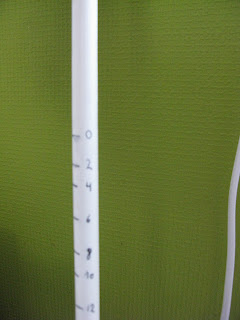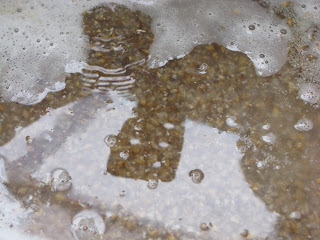HoppySlosh brews again!
What with spring being somewhat delayed, I had ample time to contemplate my next brewing endeavour. Looking foward to mowing the lawn and doing other potentially dehydrating chores around the house during the summer, I'm brewing a light, hoppy wheat beer this time; an American style hefe-weizen (or a Germanic Murkan wheat, if you will).
First things first: I need to learn how to control my brewing volumes so I'm applying science in the most advanced way possible to gauge the volumes in my kettle:
Yes, that's a (rather oversized) plastic spoon, graded by yours truly to indicate how much liquid is in my kettle. Sometimes, all you need to improve the quality of life is a permanent marker. And an oversized spoon.
Onward onward as the day wanes: mashing was a breeze. I was prepared for all kinds of disaster (*) after reading that wheat tends to clog up the filter bed, but my grain behaved perfectly, and I got a good 22 liters of turbid wort out of the tun.
*) speaking of disaster, the most important rule in brewing can be neatly summed up as this: Always check your valves. Nothing spoils the mood quite like having to start mopping when you're not even 5 minutes into the mash.
I applied a new technique (well, new for me at least) called first wort hopping.
I've been told the early addition will smoothe out the bitterness from the early hops, so here goes nothing.
Sparging went well, although I did forget to properly mash out (again). Forgot to take a pic of the pre-boil wort, but one thing I like about wheat is that it naturally clouds the wort, which means I could stop worrying about a super-clean sparge for a change.
No pic of the boil either, so you'll need to take my word for it: I added liberal doses of Centennial, Amarillo and Citra.
What with spring being somewhat delayed, I had ample time to contemplate my next brewing endeavour. Looking foward to mowing the lawn and doing other potentially dehydrating chores around the house during the summer, I'm brewing a light, hoppy wheat beer this time; an American style hefe-weizen (or a Germanic Murkan wheat, if you will).
First things first: I need to learn how to control my brewing volumes so I'm applying science in the most advanced way possible to gauge the volumes in my kettle:
 |
| The Graded Spoon |
Yes, that's a (rather oversized) plastic spoon, graded by yours truly to indicate how much liquid is in my kettle. Sometimes, all you need to improve the quality of life is a permanent marker. And an oversized spoon.
Onward onward as the day wanes: mashing was a breeze. I was prepared for all kinds of disaster (*) after reading that wheat tends to clog up the filter bed, but my grain behaved perfectly, and I got a good 22 liters of turbid wort out of the tun.
 |
| Steep steep. |
I applied a new technique (well, new for me at least) called first wort hopping.
Not hard to guess what that means.
I've been told the early addition will smoothe out the bitterness from the early hops, so here goes nothing.
Sparging. Note the state of alertness of the nearby mop.
No pic of the boil either, so you'll need to take my word for it: I added liberal doses of Centennial, Amarillo and Citra.
Post-boil tampering with the counterflow cooler.
My fifth attempt at brewing and I finally figured out how to properly cool: let gravity do the work. As you can see in the pic, I pour my boiled (and still piping hot) wort in my mash tun again, which will now serve as a filter tun. What's not in the pic is how this time I placed the tun on a stool on top of the counter, raising it high enough to no longer be a pain during cooling. Higher altitude means more hydraulic pressure chasing my wort through the cooler, and less chance of flowback or halted cooling.
Should have thought of that four sessions ago, but at least I'm improving.
After cooling, only one thing was missing. Well, two really.
Some yeast, and a lovely assistant to pitch it.
I'm using a bit of a character yeast this time: the German Hefe Weizen from White Labs (WLP300 in case you're interested) will impart spicy notes to the beer, which I hope will complement the hoppy aromas.
Fitted the airlock, forestalled any domestic disputes by cleaning up the kitchen, and a good six hours later, the yeast was going glugluglug like clockwork. Next morning, a good 5 inch of thick yeasty froth confirmed all was well with Brew#5. I'll give it about a week in primary (depending on airlock activity and density measurements), after which I'll rack it to secondary, with a generously added amout of Citra hops. From the whiffs I got off the airlock so far, this may prove to be quite drinkable.
More news as the brew progresses!
Until then,
Greetz
Jo




Geen opmerkingen:
Een reactie posten